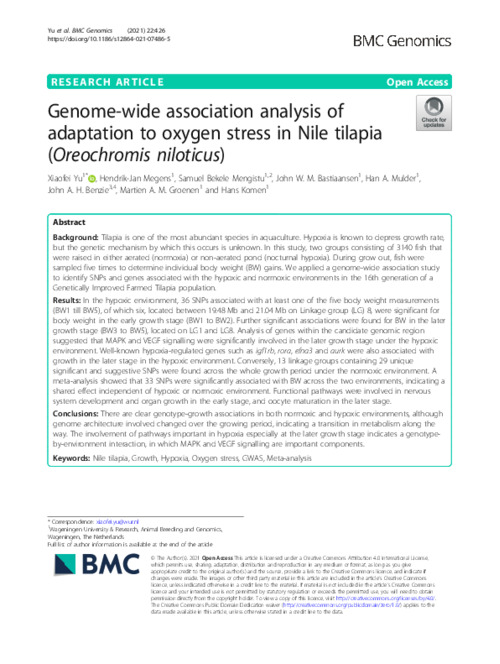Genome-wide association analysis of adaptation to oxygen stress in Nile tilapia (Oreochromis niloticus)

Background: Tilapia is one of the most abundant species in aquaculture. Hypoxia is known to depress growth rate, but the genetic mechanism by which this occurs is unknown. In this study, two groups consisting of 3140 fish that were raised in either aerated (normoxia) or non-aerated pond (nocturnal hypoxia). During grow out, fish were sampled five times to determine individual body weight (BW) gains. We applied a genome-wide association study to identify SNPs and genes associated with the hypoxic and normoxic environments in the 16th generation of a Genetically Improved Farmed Tilapia population.
Results: In the hypoxic environment, 36 SNPs associated with at least one of the five body weight measurements (BW1 till BW5), of which six, located between 19.48 Mb and 21.04 Mb on Linkage group (LG) 8, were significant for body weight in the early growth stage (BW1 to BW2). Further significant associations were found for BW in the later growth stage (BW3 to BW5), located on LG1 and LG8. Analysis of genes within the candidate genomic region suggested that MAPK and VEGF signalling were significantly involved in the later growth stage under the hypoxic environment. Well-known hypoxia-regulated genes such as igf1rb, rora, efna3 and aurk were also associated with growth in the later stage in the hypoxic environment. Conversely, 13 linkage groups containing 29 unique significant and suggestive SNPs were found across the whole growth period under the normoxic environment. A meta-analysis showed that 33 SNPs were significantly associated with BW across the two environments, indicating a shared effect independent of hypoxic or normoxic environment. Functional pathways were involved in nervous system development and organ growth in the early stage, and oocyte maturation in the later stage.
Conclusions: There are clear genotype-growth associations in both normoxic and hypoxic environments, although genome architecture involved changed over the growing period, indicating a transition in metabolism along the way. The involvement of pathways important in hypoxia especially at the later growth stage indicates a genotype-by-environment interaction, in which MAPK and VEGF signalling are important components.
Permalink
Date Available
Type
Publisher
ISSN
1471-2164
Copyright
CC-BY-4.0
Research Themes
Topics
Language